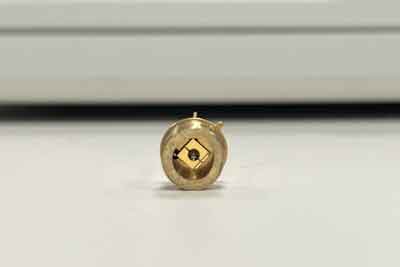Bizarre night-time solar cell generates power in a backwards process
Loz Blain
 A USNW team has measured the first power generation from a thermoradiative diode, which could be used to harvest re-emitted solar energy at night A USNW team has measured the first power generation from a thermoradiative diode, which could be used to harvest re-emitted solar energy at night
In a world first, a team at the University of New South Wales (UNSW) has demonstrated measurable power generation from "the inverse of a conventional solar cell." It could eventually produce around one tenth as much power as a solar panel – but at night.
Solar panels, as we all know, absorb energy from sunlight and convert it into electricity. To grossly oversimplify, they use two differently treated silicon semiconductor layers in what's known as a P-N junction. The N layer is doped with extra electron "donor" impurities, the P layer is doped with "acceptor" impurities – spaces for the electrons to fit into – and in the middle there's a "depletion region," where those electrons and electron-accepting holes more or less eliminate one another, creating a barrier that stops all the N side's electrons from diffusing straight through to the P side.
When sunlight shines on the cell, thermal energy in the incoming photons is absorbed in the silicon, and if an electron in the depletion region receives enough energy to jump the bandgap between the two sides, it can pop out of its hole and be accelerated across to the N side, increasing the voltage potential between the two sides. Connecting the two sides together in an external circuit, you can run the electrons back around to the P side and do electrical work.
All of which is to say, it's the thermal energy in photons coming down from the sky that kicks the process off. But this isn't just a one-way process. As our planet spins around, solar radiation heats up the Earth during the daytime, but the Earth releases that energy again as infrared light into the cool of night. And it's this flow of infrared photons into colder air that one group of UNSW researchers is working on harnessing.

Solar radiation heats up the surface during the day, but this energy is re-emitted back into the cold night sky as infra-red radiation
The research team's device is called a thermoradiative diode, and it basically works like the inverse of a solar cell, accepting thermal energy radiated upward from the Earth (or any other heat source) into a colder area, and turning the flow of energy across that temperature differential into electrical potential. It's built using some of the same materials used in infrared night vision goggles.
"It is truly the inverse of a conventional solar cell in its functionality," Dr. Michael Nielsen, a lecturer and researcher at UNSW's School of Photovoltaic and Renewable Energy Engineering, explained to us in an email. "But it still uses a semiconductor P-N junction as the core of the device (just run in reverse).
"The idea that thermodynamically we can produce power via the emission of light rather than absorption can be a stumbling block for many, but much like a solar cell, what we ultimately have here is a heat engine, with the difference being swapping the power converter from the cold side (solar cell being on Earth absorbing photons from the Sun) to the hot side (thermoradiative diode being on Earth emitting photons into the coldness of space)."
"Wherever there is a flow of energy, we can convert it between different forms," associate professor Ned Ekins-Daukes, Nielsen's co-author on the research, elaborated.

The four current-voltage operating quadrants for a photodiode: I is an LED, II is a thermoradiative diode, III is a photodetector, and IV is a photovoltaic cell
While the concept of “emissive energy harvesters” was proposed theoretically back in 2014, this new paper, published in the journal ACS Photonics, marksthe first time a thermoradiative diode has been demonstrated actually producing a measurable amount of power.
It should be noted, it's not a lot of power at this stage. With a temperature differential of just 12.5 °C, the team managed to measure a peak thermoradiative electrical power density of 2.26 mW per square meter, with an estimated radiative efficiency of 1.8 percent.
“Right now, the demonstration we have with the thermoradiative diode is relatively very low power," said A/Prof Ekins-Daukes. "One of the challenges was actually detecting it. But the theory says it is possible for this technology to ultimately produce about 1/10th of the power of a solar cell."

An infrared image of the research team shows how human body heat can also be a potential target for energy harvesting
UNSW
Indeed, it's possible to use this technology to generate power from more or less anything that glows when you look at it through a thermal camera. That could include harvesting energy from industrial waste heat, or potentially even creating bionic devices that run off the body's own heat.
The team says this is very much an early step, with a long way to go in terms of optimization and development. It hopes the commercial world will step in to fund and drive the next stages. "I think for this to be breakthrough technology, we shouldn't underestimate the need for industries to step in, and really drive it.," said Ekins-Daukes. "I'd say there's still about a decade of university research work to be done here. And then it needs industry to pick it up. If industry can see this is a valuable technology for them, then progress can be extremely fast. The miracle of solar power today owes itself to world-renowned researchers like Scientia Professor Martin Green at UNSW, but also to industrialists who have raised large sums of money to scale up manufacturing.”
The research is published in the journal ACS Photonics.
Source: UNSW
 Loz has been one of our most versatile contributors since 2007, and has since proven himself as a photographer, videographer, presenter, producer and podcast engineer, as well as a senior features writer. Joining the team as a motorcycle specialist, he's covered just about everything for New Atlas, concentrating lately on eVTOLs, hydrogen, energy, aviation, audiovisual, weird stuff and things that go fast. Loz has been one of our most versatile contributors since 2007, and has since proven himself as a photographer, videographer, presenter, producer and podcast engineer, as well as a senior features writer. Joining the team as a motorcycle specialist, he's covered just about everything for New Atlas, concentrating lately on eVTOLs, hydrogen, energy, aviation, audiovisual, weird stuff and things that go fast.
Loz spent a remarkably unfocused eight years getting an attention-deficient arts degree from Melbourne Uni, pursuing more than 30 different areas of study across the humanities and sciences on a series of whims before settling on a Psych major, back in the days when this kind of behavior didn't spell eternal financial ruin.
He worked in marketing, copywriting and communications during the dot-com boom, then as a business analyst and consultant in the software industry, then had a couple of adventurous bites at life as an international touring musician, first as a drummer, then as a singer in a successful a cappella band (Suade) and a dodgy comedy duo (Shonky Brothers), before coming on board full time with New Atlas as part of the core team.
Loz describes himself in the third person as an inch deep and a mile wide, broadly interested in people and things, addicted to the learning curve, a natural communicator, easily bored, and blessed with a good balance between technical understanding and weird, flowery, boundary-pushing creativity.
He sees his work with New Atlas as a way to celebrate, connect with and challenge the people pushing humanity forward. A father of two young kids, he is currently hyperfocusing on yoga, guitar, his long-term romance with motorcycles, and badly-needed sleep.
newatlas.com
| 

![[Most Recent Quotes from www.kitco.com]](http://www.kitconet.com/images/live/s_gold.gif)
![[Most Recent USD from www.kitco.com]](http://www.weblinks247.com/indexes/idx24_usd_en_2.gif)
![[Most Recent Quotes from www.kitco.com]](http://www.kitconet.com/images/live/s_silv.gif)


